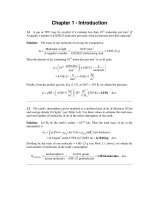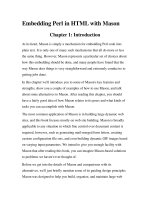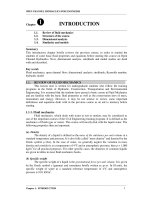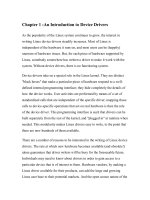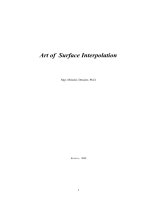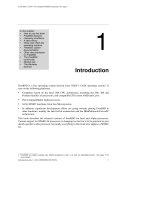Chapter 1: Course Introduction
Bạn đang xem bản rút gọn của tài liệu. Xem và tải ngay bản đầy đủ của tài liệu tại đây (452.92 KB, 24 trang )
© 2002, Cisco Systems, Inc. All rights reserved.
Configuring IP Access Lists
©©2002,
2002,Cisco
CiscoSystems,
Systems,Inc.
Inc.All
Allrights
rightsreserved.
reserved.
ICND v2.0—6-2
2
Objectives
Upon completing this lesson, you will be
able to:
• Use Cisco IOS commands to configure IP
standard and extended access lists, given a
functioning router
• Use show commands to identify anomalies in IP
standard and extended access lists, given an
operational router
© 2002, Cisco Systems, Inc. All rights reserved.
ICND v2.0—6-3
Access List Configuration Guidelines
• Access list numbers indicate which protocol is filtered.
• One access list per interface, per protocol, per direction is
allowed.
• The order of access list statements controls testing.
• Place the most restrictive statements at the top of list.
• There is an implicit deny any statement as the last access
list test. Every list needs at least one permit statement.
• Create access lists before applying them to interfaces.
• Access lists filter traffic going through the router; they do
not apply to traffic originating from the router.
© 2002, Cisco Systems, Inc. All rights reserved.
ICND v2.0—6-4
Access List Command Overview
Step 1: Set parameters for this access list test
statement (which can be one of several statements).
Router(config)#access-list access-list-number
{permit | deny} {test conditions}
Step 2: Enable an interface to use the specified
access list.
Router(config-if)#{protocol} access-group
access-list-number {in | out}
•
•
•
•
Standard IP lists (1-99)
Extended IP lists (100-199)
Standard IP lists (1300-1999) (expanded range)
Extended IP lists (2000-2699) (expanded range)
© 2002, Cisco Systems, Inc. All rights reserved.
ICND v2.0—6-5
Standard IP Access List Configuration
Router(config)#access-list access-list-number
{permit | deny | remark} source [mask]
•
•
•
•
•
Sets parameters for this list entry
IP standard access lists use 1 to 99
Default wildcard mask = 0.0.0.0
no access-list access-list-number removes entire access list
remark option lets you add a description for the access list
Router(config-if)#ip access-group
access-list-number {in | out}
•
•
•
•
Activates the list on an interface
Sets inbound or outbound testing
Default = outbound
no ip access-group access-list-number removes access list from
the interface
© 2002, Cisco Systems, Inc. All rights reserved.
ICND v2.0—6-6
Standard IP Access List
Example 1
ã Permit my network only.
â 2002, Cisco Systems, Inc. All rights reserved.
ICND v2.0—6-7
Standard IP Access List
Example 2
ã Deny a specific host.
â 2002, Cisco Systems, Inc. All rights reserved.
ICND v2.0—6-8
Standard IP Access List
Example 3
ã Deny a specific subnet.
â 2002, Cisco Systems, Inc. All rights reserved.
ICND v2.0—6-9
Extended IP Access List Configuration
Router(config)#access-list access-list-number
{permit | deny} protocol source source-wildcard [operator
port] destination destination-wildcard [operator port]
[established] [log]
• Sets parameters for this list entry
Router(config-if)#ip access-group access-list-number
{in | out}
• Activates the extended list on an interface
© 2002, Cisco Systems, Inc. All rights reserved.
ICND v2.0—6-10
Extended Access List
Example 1
• Deny FTP from subnet 172.16.4.0 to subnet 172.16.3.0 out of E0.
ã Permit all other traffic.
â 2002, Cisco Systems, Inc. All rights reserved.
ICND v2.0—6-11
Extended Access List
Example 2
• Deny only Telnet from subnet 172.16.4.0 out of E0.
ã Permit all other traffic.
â 2002, Cisco Systems, Inc. All rights reserved.
ICND v2.0—6-12
Using Named IP Access Lists
Router(config)#ip access-list {standard | extended} name
• Alphanumeric name string must be unique.
Router(config {std- | ext-}nacl)#{permit | deny}
{ip access list test conditions}
{permit | deny} {ip access list test conditions}
no {permit | deny} {ip access list test conditions}
• Permit or deny statements have no prepended number.
• “no” removes the specific test from the named access list.
Router(config-if)#ip access-group name {in | out}
• Activates the IP named access list on an interface.
© 2002, Cisco Systems, Inc. All rights reserved.
ICND v2.0—6-13
Filtering vty Access to a Router
• Five virtual terminal lines (0 through 4).
• Filter addresses that can access into the routers
vty ports.
ã Filter vty access out from the router.
â 2002, Cisco Systems, Inc. All rights reserved.
ICND v2.0—6-14
How to Control vty Access
• Set up an IP address filter with a standard access list
statement.
• Use line configuration mode to filter access with the
access-class command.
• Set identical restrictions on every vty.
© 2002, Cisco Systems, Inc. All rights reserved.
ICND v2.0—6-15
vty Commands
Router(config)#line vty {vty# | vty-range}
• Enters configuration mode for a vty or vty range
Router(config-line)#access-class access-list-number
{in | out}
• Restricts incoming or outgoing vty connections for
address in the access list
© 2002, Cisco Systems, Inc. All rights reserved.
ICND v2.0—6-16
vty Access Example
Controlling Inbound Access
access-list 12 permit 192.168.1.0 0.0.0.255
(implicit deny all)
!
line vty 0 4
access-class 12 in
• Permits only hosts in network 192.168.1.0 0.0.0.255 to
connect to the router vty
© 2002, Cisco Systems, Inc. All rights reserved.
ICND v2.0—6-17
Access List Configuration Principles
• The order of access list statements is crucial.
– Recommended: Use a text editor on a PC to create the
access-list statements, then cut and paste them into the
router.
– Top-down processing is important.
– Place the more specific test statements first.
• No reordering or removal of statements.
– Use the no access-list number command to remove the
entire access list.
– Exception: Named access lists permit removal of individual
statements.
• Implicit deny all will be applied to any packets that do not
match any access-list statement.
– Unless the access list ends with an explicit permit any
statement.
© 2002, Cisco Systems, Inc. All rights reserved.
ICND v2.0—6-18
Where to Place IP Access Lists
• Place extended access lists close to the source.
• Place standard access lists close to the destination.
© 2002, Cisco Systems, Inc. All rights reserved.
ICND v2.0—6-19
Verifying Access Lists
wg_ro_a#show ip interfaces e0
Ethernet0 is up, line protocol is up
Internet address is 10.1.1.11/24
Broadcast address is 255.255.255.255
Address determined by setup command
MTU is 1500 bytes
Helper address is not set
Directed broadcast forwarding is disabled
Outgoing access list is not set
Inbound access list is 1
Proxy ARP is enabled
Security level is default
Split horizon is enabled
ICMP redirects are always sent
ICMP unreachables are always sent
ICMP mask replies are never sent
IP fast switching is enabled
IP fast switching on the same interface is disabled
IP Feature Fast switching turbo vector
IP multicast fast switching is enabled
IP multicast distributed fast switching is disabled
<text ommitted>
© 2002, Cisco Systems, Inc. All rights reserved.
ICND v2.0—6-20



